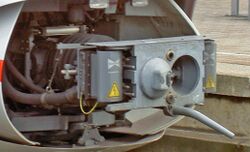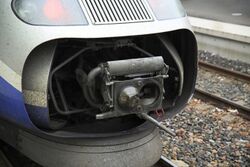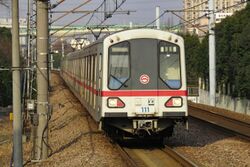Engineering:Scharfenberg coupler

The Scharfenberg coupler[1] (German: Scharfenbergkupplung, abbreviated Schaku) is a commonly used type of fully automatic railway coupling.
Designed in 1903 by Karl Scharfenberg in Königsberg, Germany (today Kaliningrad, Russia), the coupler has gradually spread from transit trains to regular passenger service trains, although outside Europe its use is generally restricted to mass transit systems. The Schaku is superior in many ways to the AAR (Janney/knuckle) coupler because it also automates electrical and pneumatic connections and disconnections. However, there is no standard for the placement of these electro-pneumatic connections. Some rail operators have placed them on the sides while others have placed them either below or above the mechanical portion of the coupler.[dubious ]
Working principles
The face of the Scharfenberg coupler has a protruding cone and a matching cup. Inside the cone there is a rigid metal hoop connected to a revolving, spring-loaded metal disk with a notch on the opposite side. When ready to couple, the spring turns the disk so the hoop is extended from the cone. As the cars meet, the hoop enters the cup on the other coupler, stopping against the disk. The hoops are then pressed back into their own coupler, causing the disks to rotate until the notches align with the hoops. After the hoops have entered, the notches on the disks spring back into the hoop extended position, locking the coupling. In the coupled position, forces on the hoops and disk will balance out, which means that the Scharfenberg, unlike many other couplers, is not dependent on heavy latches to stay locked.
Small air cylinders, acting on the rotating heads of the coupler, ensure the engagement of the components, making it unnecessary to use force to get a good coupling. Joining portions of a passenger train can be done at very low speed (less than 3 km/h or 2 mph in the final approach), so that the passengers are not jolted. One problem with the coupler is that it is often hard to connect it in a curve. Planned coupling is normally done on a straight flat track, while there has been trouble coupling a broken down train at an unplanned place.
- Scharfenberg couplers
Uses
File:Pendeltåg kopplas ihop.webm Rail equipment manufacturers such as Alstom offer the Schaku as an option on their mass transit passenger cars and locomotives. Presently, Scharfenberg couplers are in use on the following passenger transit systems:
Australia
- Victoria - V/Line (VLocity 160, Sprinter), Metro Trains Melbourne (Comeng, X'Trapolis 100 [also used in Chile])
- New South Wales - Sydney Trains (T, M, A & B sets)
- New South Wales - NSW TrainLink (Endeavour railcar and Xplorer)
- Western Australia - Transperth (A-series, B-series train)
- South Australia - Adelaide Metro (3000 class railcar)
- Queensland - Queensland Rail (EMU, ICE, SMU, IMU, NGR)
Spain
- Renfe commuter, regional and high speed trainsets and multiple units
- Talgo III trainsets (now retired)
- Euskotren EMUs
- FGV trainsets
- Madrid, Barcelona and Bilbao metros (some are used only if a train needs to be towed)
- CAF Urbos trams (towing only, some adapted with electric connections)
- Iryo and Ouigo high speed trainsets
- Feve (now renfe) electric and diesel multiple units
Saudi Arabia
- Haramin High Speed Train - Talgo 350 train
United States
- San Francisco Bay Area - BART (New Type D and E vehicles)
- San Francisco Bay Area - Muni Metro (New Type 4 vehicles)
- Denver - RTD Bus & Rail (New light rail vehicles)
- Baltimore - Baltimore Light RailLink (New light rail vehicles)
- New Jersey - New Jersey Transit (New light rail vehicles)
- Portland, Oregon - TMTC (Light rail vehicles)
- Minneapolis - METRO (Light rail vehicles)
- Norfolk, Virginia - HRT (Light rail vehicles)
- San Diego County, California (NCTD Sprinter hybrid rail)
Canada
Europe
- Thalys
- TGV – All French high-speed trains are equipped with Scharfenberg type 10 couplers.
- ICE – All German high-speed trains are equipped with Scharfenberg type 10 couplers.
- Many regional train EMUs and DMUs in Europe
- Rhine-Ruhr Stadtbahn - Almost all German light-rail and streetcar systems use Scharfenberg couplers.
- SBB Cargo – In 2019, the swiss freight operator introducing cargo wagons with Voith CargoFlex, an extension of Scharfenberg type 10 couplers.
- Channel Tunnel - Eurotunnel Le Shuttle
- Narrow-gauge railways in Saxony, Germany
United Kingdom
- Class 175 Alstom "Coradia"[2]
- Class 180 Alstom "Adelante", used on Grand Central[3]
- Class 185 Siemens "Desiro", operated by TransPennine Express.
- Class 332[4]
- Class 333[5]
- Some UK Hitachi A-train AT300 including the Class 395 Javelin AT300, Class 801 Azuma AT300, and Class 802 IET/Nova 1/Paragon AT300, Class 803 AT300, and the under construction/in testing Class 805 AT300, Class 807 AT300, Class 810 Aurora AT300.[citation needed]
- London Underground 2009 Stock
- Glasgow Subway 3rd Generation Rolling Stock[6]
Brazil
- São Paulo - Companhia Paulista de Trens Metropolitanos (All vehicles, except 1700 and 5400 series)
- São Paulo - Companhia do Metropolitano de São Paulo (Type F, M and P vehicles)
Indonesia
- Soekarno–Hatta Airport Skytrain
Philippines
- Metro Manila MRT Line 3 Class 3000 and Class 3100
Singapore
- Mass Rapid Transit
Taiwan
- Taipei - Taipei Metro (Matra VAL 256 and Bombardier Innovia APM 256)
- New Taipei City - New Taipei Metro (Hitachi Rail Italy Driverless Metro (4-car and 2-car))
- Taoyuan - Taoyuan Airport MRT (Commuter and Express)
- Taichung - Taichung Metro (Kawasaki/TRSC EMU)
- Kaohsiung - Kaohsiung Metro (Siemens Modular Metro)
Thailand
- Bangkok - BTS Skytrain, MRT, Airport Rail Link and SRT Red Lines
New Zealand
- Auckland - AM class
- Wellington - FP/FT class
Types
Voith is known to offer the following types of Scharfenberg couplers:[7]
- Type 10: Used for mainline railways and high speed rail applications
- Type 35: Designed for rolling stock without a compressed air system and used for urban transit applications
- Type 330: Used for trams and light rail transit
- Type 430/530: A folding coupler designed for low-floor trams and monorails
- Type 55: Designed for shunting purposes
- Type 140: Designed for industrial railways
- CargoFlex: For freight trains, based on the type 10 Scharfenberg coupler head
- CargoFlex Hybrid: For locomotives, based on the type 10 Scharfenberg coupler head, can be used with both automatic and screw couplers
See also
- Janney coupler
- Draft gear
- Railway coupling by country
References
- ↑ us.voithturbo.com: Scharfenberg coupler
- ↑ "Class 175 - Arriva Trains Wales". https://www.angeltrains.co.uk/Products-Services/Regional-Passenger-Trains/42.
- ↑ "Class 180". http://www.therailwaycentre.com/New%20DMU%20Tech%20Data%20/DMU_180.html.
- ↑ "System Data for Mechanical and Electrical Coupling of Rail Vehicles". Rail Safety and Standards Board. Archived from the original on 5 July 2008. https://web.archive.org/web/20080705034433/http://www.rssb.co.uk/rv_coupling_system_data/list_index.asp.
- ↑ "Class 333 - Northern Rail (by Arriva)" (in en-GB). https://www.angeltrains.co.uk/Products-Services/Regional-Passenger-Trains/16.
- ↑ Lo, Chris (2019-08-12). "In pictures: Glasgow Subway shows off its new driverless trains" (in en-US). https://rail.nridigital.com/future_rail_aug19/in_pictures_glasgow_subway_shows_off_its_new_driverless_trains.
- ↑ "Scharfenberg couplers". https://voith.com/corp-en/connection-components-couplings/railway-couplers.html.
External links
 |




